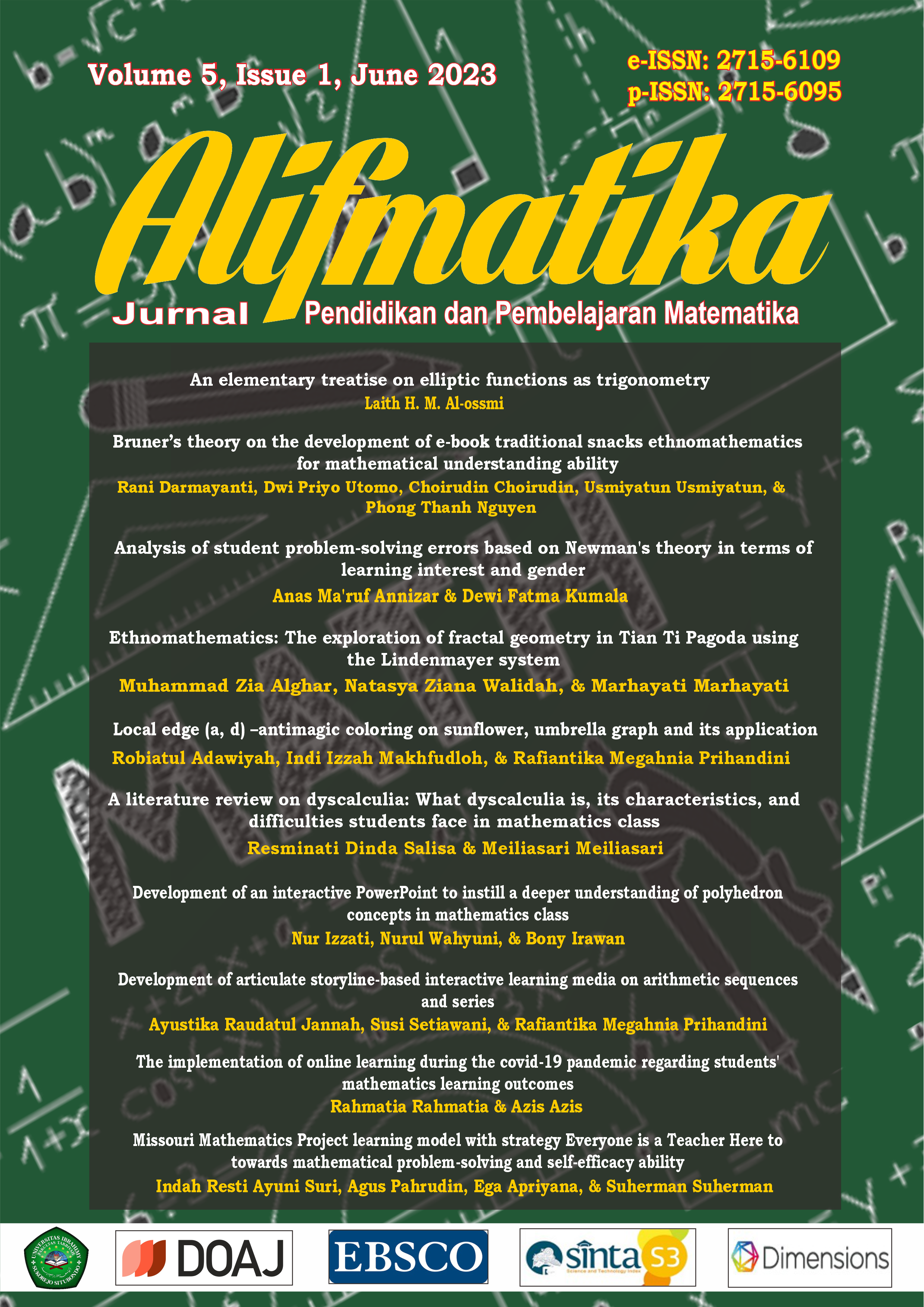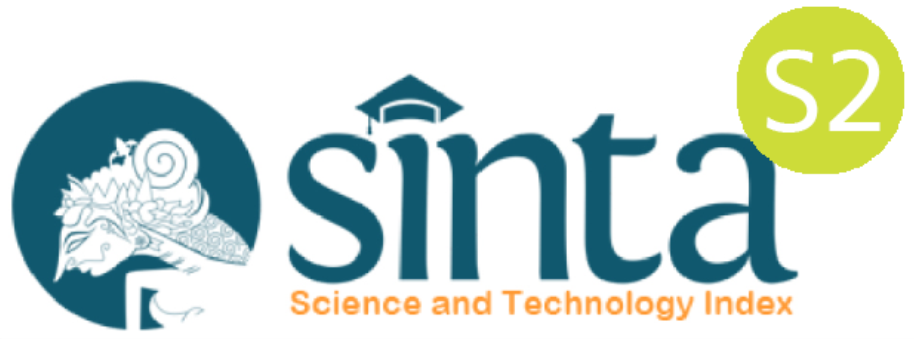Ethnomathematics: The exploration of fractal geometry in Tian Ti Pagoda using the Lindenmayer system
DOI:
https://doi.org/10.35316/alifmatika.2023.v5i1.57-69Keywords:
Ethnomathematics, Fractal Geometry, Lindenmayer System, Tian Ti PagodaAbstract
This study explores the concept of fractal geometry found in the Tian Ti Pagoda. Fractal geometry is a branch of mathematics describing the properties and shapes of various fractals. A qualitative method with an ethnographic approach is used in this study. Observation, field notes, interviews, documentation, and literature study obtained research data. The observation results were processed computationally using the Lindenmayer system method via the L-Studio application to view fractal shapes. The results show that the concept of fractal geometry is contained in the ornaments on the Tian Ti Pagoda. The length and angles of each part of the ornament influence the fractal shape of the Tian Ti Pagoda ornament. In addition, the length and angle modifications resulted in several variations of the Tian Ti Pagoda fractal. The findings from this study can be used as an alternative medium for learning mathematics lectures, especially in applied mathematics, dynamical systems, and computational geometry.
Downloads
References
Abu-Elwan, R. (2014). The effect of teaching chaos theory and fractal geometry on geometric reasoning skills of secondary students. International Journal of Research in Education Methodology, 6(2), 804–814. https://doi.org/10.24297/ijrem.v6i2.3876
Alghar, M. Z., Susanti, E., & Marhayati, M. (2022). Ethnomathematics: Arithmetic sequence patterns of minangkabau carving on singok gonjong. Jurnal Pendidikan Matematika (Jupitek), 5(2), 145–152. https://doi.org/10.30598/jupitekvol5iss2pp145-152
Bahar, A. K., & Maker, C. J. (2020). Culturally responsive assessments of mathematical skills and abilities: Development, field testing, and implementation. Journal of Advanced Academics, 31(3), 211–233. https://doi.org/10.1177/1932202X20906130
Bernard, J., & McQuillan, I. (2021). Techniques for inferring context-free Lindenmayer systems with genetic algorithm. Swarm and Evolutionary Computation, 64(100893), 1–12. https://doi.org/10.1016/j.swevo.2021.100893
Chowdary, P. S. R., Prasad, A. M., Rao, P. M., & Anguera, J. (2015). Design and performance study of Sierpinski fractal based patch antennas for multiband and miniaturization characteristics. Wireless Personal Communications, 83, 1713–1730. https://doi.org/10.1007/s11277-015-2472-5
d’Ambrosio, U. (2001). In my opinion: what is ethnomathematics, and how can it help children in schools? National Council of Teachers of Mathematics (NCTM), 7(6), 308–310. https://doi.org/10.5951/tcm.7.6.0308
Ditasona, C. (2018). Ethnomathematics exploration of the Toba community: Elements of geometry transformation contained in Gorga (ornament on Bataks house). In Ramli, M. Azhar, & R. Sumarmin (Ed.), IOP Conference Series: Materials Science and Engineering (pp. 1–6). Universitas Negeri Padang. https://doi.org/10.1088/1757-899X/335/1/012042
Dye, D. S. (2012). Chinese lattice designs. Courier Corporation.
Fitriza, R. (2018). Ethnomathematics pada ornamen rumah gadang minangkabau. Math Educa Journal, 2(2), 181–190. https://doi.org/10.15548/mej.v2i2.187
Gerdes, P. (2017). Interweaving geometry and art: Examples from africa. In K. Fenyvesi & T. Lähdesmäki (Ed.), Aesthetics of Interdisciplinarity: Art and Mathematics (pp. 181–195). Birkhäuser, Cham. https://doi.org/10.1007/978-3-319-57259-8_10
Juhari, J., & Alghar, M. Z. (2021). Modeling plant stems using the deterministic lindenmayer system. Journal Cauchy, 6(4), 286–295. https://doi.org/10.18860/ca.v6i4.11591
Juniati, D., & Budayasa, I. K. (2017). Pengembangan bahan ajar geometri fraktal berbasis eksperimen untuk meningkatkan kompetensi mahasiswa [Development of experimental-based fractal geometry teaching materials to improve student competence]. Jurnal Cakrawala Pendiidkan, 1(1), 24–33. https://doi.org/10.21831/cp.v36i1.11660
Kushwaha, N., & Kumar, R. (2013). An UWB fractal antenna with defected ground structure and swastika shape electromagnetic band gap. Progress In Electromagnetics Research B, 52, 383–403. https://doi.org/10.2528/PIERB13051509
Lee-Kalisch, J. (2018). The Transmission of ornaments in buddhist art: On the meander or huiwen. Hualin International Journal of Buddhist Studies, 1(2), 111–130. https://doi.org/10.15239/hijbs.01.02.04
Lee, S. Y., & Tiong, K. M. (2013). Algorithmic generation of Chinese lattice designs. International Journal of Computer and Communication Engineering, 2(6), 706–710. https://doi.org/10.7763/IJCCE.2013.V2.279
Nassar, M., & Sabbagh, A. (2016). The geometric mosaics at Khirbat Mar Elyas: A comparative study. Greek, Roman, and Byzantine Studies, 56(3), 528–555.
Orey, D. C., & Rosa, M. (2008). Ethnomathematics and cultural representations: Teaching in highly diverse contexts. Journal Acta Scientiae, 10(1), 27–46.
Prusinkiewicz, P., & Lindenmayer, A. (2012). The algorithmic beauty of plants. Springer Science & Business Media.
Romadiastri, Y. (2017). Batik fraktal: Perkembangan aplikasi geometri fraktal [Fractal batik: The development of fractal geometry applications]. Delta: Jurnal Ilmiah Pendidikan Matematika, 1(2), 158–164. https://doi.org/10.31941/delta.v1i2.484
Shomakhmadov, S. H. (2012). The features of the interpretation of mañgala-symbols in buddhist sanskrit manuscripts from central asia. Manuscripta Orientalia. International Journal for Oriental Manuscript Research, 18(2), 9–23.
Sulaiman, H., & Firmasari, S. (2020). Analisis geometri fraktal pada bentuk bangunan di komplek keraton kanoman cirebon [Fractal geometry analysis on building forms in the Kanoman Cirebon palace complex]. Euclid, 7(1), 51–60. https://doi.org/10.33603/e.v7i1.2831
Sulaiman, H., & Nasir, F. (2020). Ethnomathematics: Mathematical aspects of panjalin traditional house and its relation to learning in schools. Al-Jabar: Jurnal Pendidikan Matematika, 11(2), 247–260. https://doi.org/10.24042/ajpm.v11i2.7081
Wen, Z. (2011). Chinese Motifs of Good Fortune. Better Link.
Xu, C., Huang, Y., & Dewancker, B. (2020). Art inheritance: An education course on traditional pattern morphological generation in architecture design based on digital Sculpturism. Sustainability, 12(9), 3752. https://doi.org/10.3390/su12093752
Yi, T. (2004). A Technology–Enhanced Fractal/Chaos Course. Electronic Proceeding of the Seventeenth Annual International Conference on Technology in Colligate Mathematics, 1–6.
Yildiz, A., & Baltaci, S. (2017). Reflections from the lesson study for the development of techno-pedagogical competencies in teaching fractal geometry. European Journal of educational research, 6(1), 41–50. https://doi.org/10.12973/eu-jer.6.1.41
Yuniana, E. R. (2016). Pagoda Tian Ti Studi Deskriptif Mengenai Makna Simbol pada Bangunan Pagoda Tian Ti di Kenpark, Surabaya [A Descriptive Study of the Symbolic Meanings of the Tian Ti Pagoda Building in Kenpark, Surabaya]. [Unpublished Thesis]. Universitas Airlangga.
Downloads
Published
How to Cite
Issue
Section
License
Copyright (c) 2023 Alifmatika: Jurnal Pendidikan dan Pembelajaran Matematika

This work is licensed under a Creative Commons Attribution-ShareAlike 4.0 International License.
COPYRIGHT NOTICE
Author (s) who publish in Alifmatika: Jurnal Pendidikan dan Pembelajaran Matematika agree to the following terms:
- The Author (s) submitting a manuscript do so on the understanding that if accepted for publication, copyright of the article shall be assigned to Alifmatika: Jurnal Pendidikan dan Pembelajaran Matematika, Tarbiyah Faculty of Ibrahimy University as the publisher of the journal. Consecutively, author(s) still retain some rights to use and share their own published articles without written permission from Alifmatika: Jurnal Pendidikan dan Pembelajaran Matematika. This work is licensed under a Creative Commons Attribution-ShareAlike 4.0 International License.
- Copyright encompasses rights to publish and provide the manuscripts in all forms and media for the purpose of publication and dissemination, and the authority to enforce the rights in the manuscript, for example in the case of plagiarism or in copyright infringement.
- Alifmatika: Jurnal Pendidikan dan Pembelajaran Matematika and the Editors make every effort to ensure that no wrong or misleading data, opinions or statements be published in the journal. In any way, the contents of the articles and advertisements published in Alifmatika: Jurnal Pendidikan dan Pembelajaran Matematika are the sole responsibility of their respective authors and advertisers.
- The Copyright Transfer Form can be downloaded here [Copyright Transfer Form Alifmatika]. The copyright form should be signed originally and send to the Editorial Office in the form of original mail, scanned document to alifmatika[at]ibrahimy.ac.id or upload the scanned document in the comments column when sending the manuscript.























_by_Matematohir.jpg)






